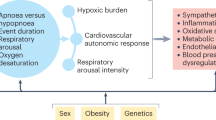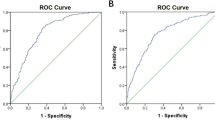Abstract
Atrial fibrillation (AF) and obesity are coinciding epidemics. Obstructive sleep apnea (OSA) correlates directly with obesity and is highly prevalent among middle-aged adults. Emerging evidence supports a strong association between AF and OSA. The rate of AF among patients with OSA is low but is nevertheless higher than that in the general population. The prevalence of OSA among patients with AF is strikingly high—at least 32% and possibly as high as 49%—although differences in the AF populations studied and the criteria used to diagnose OSA have prevented more accurate measurement of this rate. Data in focused populations at risk of AF show that OSA increases the frequency and recurrence of AF. These findings cannot, however, be reliably generalized to the larger OSA population. Although the available information is limited, treatment of OSA, particularly with continuous positive airway pressure, seems to substantially reduce the frequency of AF. If true, this approach would provide a safe and noninvasive therapy for some patients with AF. Randomized controlled trials are necessary to rigorously answer this question. Many data have been obtained from studies with focuses other than the direct relationship between OSA and AF. Studies carefully designed to investigate the relevant issues are now needed.
This is a preview of subscription content, access via your institution
Access options
Subscribe to this journal
Receive 12 print issues and online access
$209.00 per year
only $17.42 per issue
Buy this article
- Purchase on Springer Link
- Instant access to full article PDF
Prices may be subject to local taxes which are calculated during checkout
Similar content being viewed by others
References
Braunwald E (1997) Shattuck lecture—cardiovascular medicine at the turn of the millennium: triumphs, concerns, and opportunities. N Engl J Med 337: 1360–1369
Go AS et al. (2001) Prevalence of diagnosed atrial fibrillation in adults: national implications for rhythm management and stroke prevention: the AnTicoagulation and Risk Factors in Atrial Fibrillation (ATRIA) Study. JAMA 285: 2370–2375
Benjamin EJ et al. (1998) Impact of atrial fibrillation on the risk of death: the Framingham Heart Study. Circulation 98: 946–952
Hedley AA et al. (2004) Prevalence of overweight and obesity among US children, adolescents, and adults, 1999–2002. JAMA 291: 2847–2850
Coromilas J (2004) Obesity and atrial fibrillation: is one epidemic feeding the other? JAMA 292: 2519–2520
Gami AS et al. (2003) Obesity and obstructive sleep apnea. Endocrinol Metab Clin North Am 32: 869–894
Young T et al. (1993) The occurrence of sleep-disordered breathing among middle-aged adults. N Engl J Med 328: 1230–1235
Fuster V et al. (2001) ACC/AHA/ESC Guidelines for the Management of Patients With Atrial Fibrillation: Executive Summary. A Report of the American College of Cardiology/American Heart Association Task Force on Practice Guidelines and the European Society of Cardiology Committee for Practice Guidelines and Policy Conferences (Committee to Develop Guidelines for the Management of Patients With Atrial Fibrillation) Developed in Collaboration With the North American Society of Pacing and Electrophysiology. Circulation 104: 2118–2150
Lloyd-Jones DM et al. (2004) Lifetime risk for development of atrial fibrillation: the Framingham Heart Study. Circulation 110: 1042–1046
Valencia-Flores M et al. (2000) Prevalence of sleep apnea and electrocardiographic disturbances in morbidly obese patients. Obes Res 8: 262–269
Mooe T et al. (2000) Cardiac rhythm in patients with sleep-disordered breathing and coronary artery disease. Scand Cardiovasc J 34: 272–276
Hoffstein V and Mateika S (1994) Cardiac arrhythmias, snoring, and sleep apnea. Chest 106: 466–471
Guilleminault C et al. (1983) Cardiac arrhythmia and conduction disturbances during sleep in 400 patients with sleep apnea syndrome. Am J Cardiol 52: 490–494
Flemons WW et al. (1993) Sleep apnea and cardiac arrhythmias. Is there a relationship? Am Rev Respir Dis 148: 618–621
Javaheri S et al. (1998) Sleep apnea in 81 ambulatory male patients with stable heart failure. Types and their prevalences, consequences, and presentations. Circulation 97: 2154–2159
Sin DD et al. (1999) Risk factors for central and obstructive sleep apnea in 450 men and women with congestive heart failure. Am J Respir Crit Care Med 160: 1101–1106
Mooe T et al. (1996) Sleep-disordered breathing: a novel predictor of atrial fibrillation after coronary artery bypass surgery. Coron Artery Dis 7: 475–478
Kanagala R et al. (2003) Obstructive sleep apnea and the recurrence of atrial fibrillation. Circulation 107: 2589–2594
Wang TJ et al. (2004) Obesity and the risk of new-onset atrial fibrillation. JAMA 292: 2471–2477
Hall MJ et al. (1998) Magnitude and time course of hemodynamic responses to Mueller maneuvers in patients with congestive heart failure. J Appl Physiol 85: 1476–1484
Schafer H et al. (1998) Pulmonary haemodynamics in obstructive sleep apnoea: time course and associated factors. Eur Respir J 12: 679–684
Tkacova R et al. (1998) Effects of continuous positive airway pressure on obstructive sleep apnea and left ventricular afterload in patients with heart failure. Circulation 98: 2269–2275
Alchanatis M et al. (2000) Left ventricular function in patients with obstructive sleep apnoea syndrome before and after treatment with nasal continuous positive airway pressure. Respiration 67: 367–371
Niroumand M et al. (2001) Impact of obstructive sleep apnea on left ventricular mass and diastolic function. Am J Respir Crit Care Med 163: 1632–1636
Kraiczi H et al. (2001) Impairment of vascular endothelial function and left ventricular filling: association with the severity of apnea-induced hypoxemia during sleep. Chest 119: 1085–1091
Fung JW et al. (2002) Severe obstructive sleep apnea is associated with left ventricular diastolic dysfunction. Chest 121: 422–429
Pritchett AM et al. (2005) Diastolic dysfunction and left atrial volume: a population-based study. J Am Coll Cardiol 45: 87–92
Young T et al. (1997) Estimation of the clinically diagnosed proportion of sleep apnea syndrome in middle-aged men and women. Sleep 20: 705–706
Young T et al. (2002) Epidemiology of obstructive sleep apnea: a population health perspective. Am J Respir Crit Care Med 165: 1217–1239
Sleep-related breathing disorders in adults: recommendations for syndrome definition and measurement techniques in clinical research. The Report of an American Academy of Sleep Medicine Task Force. (1999) Sleep 22: 667–689
Porthan KM et al. (2004) Prevalence of sleep apnea syndrome in lone atrial fibrillation: a case-control study. Chest 125: 879–885
Gami AS et al. (2004) Association of atrial fibrillation and obstructive sleep apnea. Circulation 110: 364–367
Benjamin EJ et al. (1994) Independent risk factors for atrial fibrillation in a population-based cohort. The Framingham Heart Study. JAMA 271: 840–844
Shamsuzzaman AS et al. (2003) Obstructive sleep apnea: implications for cardiac and vascular disease. JAMA 290: 1906–1914
Roche F et al. (2003) Relationship among the severity of sleep apnea syndrome, cardiac arrhythmias, and autonomic imbalance. Pacing Clin Electrophysiol 26: 669–677
Wright J et al. (1997) Health effects of obstructive sleep apnoea and the effectiveness of continuous positive airways pressure: a systematic review of the research evidence. BMJ 314: 851–860
Zohar Y et al. (1992) Cardiac function in obstructive sleep apnea patients following uvulopalatopharyngoplasty. Otolaryngol Head Neck Surg 107: 390–394
Peiser J et al. (1985) Cardiac arrhythmias during sleep in morbidly obese sleep-apneic patients before and after gastric bypass surgery. Clin Cardiol 8: 519–521
Koehler U et al. (1998) Heart block in patients with obstructive sleep apnoea: pathogenetic factors and effects of treatment. Eur Respir J 11: 434–439
Harbison J et al. (2000) Cardiac rhythm disturbances in the obstructive sleep apnea syndrome: effects of nasal continuous positive airway pressure therapy. Chest 118: 591–595
Somers VK et al. (1995) Sympathetic neural mechanisms in obstructive sleep apnea. J Clin Invest 96: 1897–1904
Ohga E et al. (2003) Effects of obstructive sleep apnea on circulating ICAM-1, IL-8, and MCP-1. J Appl Physiol 94: 179–184
Pepperell JC et al. (2002) Ambulatory blood pressure after therapeutic and subtherapeutic nasal continuous positive airway pressure for obstructive sleep apnoea: a randomised parallel trial. Lancet 359: 204–210
Becker HF et al. (2003) Effect of nasal continuous positive airway pressure treatment on blood pressure in patients with obstructive sleep apnea. Circulation 107: 68–73
Peled N et al. (1999) Nocturnal ischemic events in patients with obstructive sleep apnea syndrome and ischemic heart disease: effects of continuous positive air pressure treatment. J Am Coll Cardiol 34: 1744–1749
Sin DD et al. (2000) Effects of continuous positive airway pressure on cardiovascular outcomes in heart failure patients with and without Cheyne-Stokes respiration. Circulation 102: 61–66
Kaneko Y et al. (2003) Cardiovascular effects of continuous positive airway pressure in patients with heart failure and obstructive sleep apnea. N Engl J Med 348: 1233–1241
Mansfield DR et al. (2004) Controlled trial of continuous positive airway pressure in obstructive sleep apnea and heart failure. Am J Respir Crit Care Med 169: 361–366
Liston R et al. (1995) Haemodynamic effects of nasal continuous positive airway pressure in severe congestive heart failure. Eur Respir J 8: 430–435
Kiely JL et al. (1998) Efficacy of nasal continuous positive airway pressure therapy in chronic heart failure: importance of underlying cardiac rhythm. Thorax 53: 957–962
Acknowledgements
ASG, SMC and VKS are supported by grants from the National Institutes of Health (NIH) and the Mayo Foundation. ASG is also supported by the Dr Ralph and Marian C Falk Medical Research Trust Fellowship.
Author information
Authors and Affiliations
Corresponding author
Ethics declarations
Competing interests
Virend K Somers has acted as a consultant for ResMed and Respironics Inc.
Glossary
- OBSTRUCTIVE SLEEP APNEA (OSA)
-
A form of sleep apnea caused by upper airway anatomic and functional characteristics, in which efforts to breathe continue during airflow cessation
- APNEA–HYPOPNEA INDEX (AHI)
-
An index that relates the severity of sleep apnea and hypopnea, calculated as the average number of apneas and hypopneas per hour of sleep; score <5 is normal
- SLEEP APNEA
-
A breathing disorder characterized by repeated episodes of part or complete cessation of breathing during sleep
- CENTRAL SLEEP APNEA
-
A form of sleep apnea in which no effort is made to breathe during airflow cessation due to defects in central nervous system ventilation control
- OXYGEN DESATURATION INDEX
-
An index to assess the severity of sleep apnea, calculated as the average number of oxygen desaturation episodes per hour of sleep
- CONTINUOUS POSITIVE AIRWAY PRESSURE (CPAP) THERAPY
-
Airway pressure is maintained above atmospheric pressure during the ventilatory cycle by pressurization of the airway via a face mask
Rights and permissions
About this article
Cite this article
Gami, A., Friedman, P., Chung, M. et al. Therapy Insight: interactions between atrial fibrillation and obstructive sleep apnea. Nat Rev Cardiol 2, 145–149 (2005). https://doi.org/10.1038/ncpcardio0130
Received:
Accepted:
Issue Date:
DOI: https://doi.org/10.1038/ncpcardio0130
This article is cited by
-
Transoral Robotic Surgery for Obstructive Sleep Apnea
Current Otorhinolaryngology Reports (2019)
-
The why, when and how to test for obstructive sleep apnea in patients with atrial fibrillation
Clinical Research in Cardiology (2018)
-
Detection of sleep-disordered breathing with ambulatory Holter monitoring
Sleep and Breathing (2018)
-
Lungenerkrankungen und Herzfunktion
Der Internist (2007)



